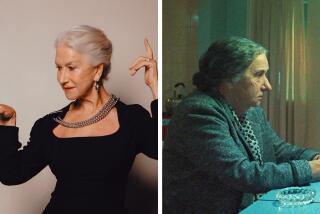Bob Newton’s mechanical horses gallop for ‘Lone Ranger’
- Share via
Bob Newton, production coordinator at Creature Effects Inc., likes working with mechanical horses for practical reasons. “You don’t have to clean up after them, and you don’t have to feed them,” he says. The Los Angeles-based company supplied trusty, low-maintenance steeds for Disney’s “The Lone Ranger,” which arrives in theaters Wednesday.
Newton, 57, has always liked making things — whether generating animatronics in a machine shop or creating sculptures with a welding torch. Born in Los Angeles and raised in Portland, Ore., he studied fine arts at Portland State University. Before finishing his degree, he rode his bicycle from Oregon to Southern California, where he launched a career in graphic arts at a multinational planning corporation in Orange County. He left the corporate world to build puppets and sets for a children’s television show, which was never picked up, and later formed a construction company, building houses and doing remodeling.
After a friend asked for help on a low-budget horror flick, Newton ended up spending the next 20 years working in the film industry, initially at Steve Johnson’s XFX special effects studio in Santa Monica. In his current job at Creature Effects, Newton does everything from answering phone calls to operating animatronics on set as a puppeteer. He’s worked on such productions as 1995’s “Species,” 1999’s “Bicentennial Man” and 2007’s “I Am Legend.”
PHOTOS: Hollywood backlot moments
“We do a whole range of things from special effects makeup to fully animatronic pieces to props, and I would say a good 20% of our business is horses,” Newton said. “It seems like the idea of the western is never going to die, which is a great thing for us. I love westerns.”
Machine project: As the Lone Ranger and Tonto, actors Armie Hammer and Johnny Depp had mechanical doubles of their horses Silver and Scout. Newton oversaw the construction of the horses, fashioned from foam latex, polyester fur fiber, metal, gears and electric motors. It took more than three months to make each mechanical interior and another three to fabricate the horse skin. Newton designed some of the mechanics of the horse ears.
“On our fully mechanical horses, the running motion and the movement of the musculature under the horses’ legs is operated by motors that are on controls operated by the puppeteers,” said Newton. “So we can ramp that motion up to a full gallop and then ramp it back down to a slower gallop.”
PHOTOS: Celebrities by The Times
Death proof: Creature Effects works closely with the American Humane Assn., which is charged with overseeing the welfare of animals on sets, to substitute mechanical animals during dangerous stunts. For a scene in which the Lone Ranger rides Silver through train cars, the production ran the mechanical version along a dolly track. “There were massive bullet hits going off, glass shattering and stuff that would be very compromising to a real horse put in that situation,” explained Newton.
All ears: The faster the gallop, the flatter the ears. According to Newton, “When a horse is standing, generally, their ears are facing forward. But as they begin to run, the horse doesn’t like all that air catching in the ears, so they turn their ears backward. Our mechanical heads have the ability to rotate the ears and also lay the ears back, which is what a horse does when it’s at a full run.” The mechanical horses also blink their eyes, giving “a sense that the horse is alive when you see it on camera.”
A horse of a different color: Newton says that there’s more than one way to skin a horse. “It’s fairly easy to swap out the skins on the horses,” he said. “The two white skins are Silver’s skins. We had multiples, because we knew that there were going to be circumstances where they might get damaged. And Scout is what they call a painted horse — not all solid color.” He added, “We make a great effort to use all synthetic furs and fabrics, so we’re not harming real animals. In the instance of the horse, it’s polyester fiber that’s cut very short.”
VIDEO: ‘The Lone Ranger’ trailer
Hoofing it: Detached horse legs also come in handy on film sets. “There was a scene where Silver paws at the Lone Ranger,” said Newton. “The horse is trying to get his attention. So that was an insert leg that we used that had some mechanics in it that would allow the horse to paw at him. Then we have a couple of kicking legs that we’ve used for various things, and that’s pretty convincing as well.”
Comfort zone: The real horses aren’t the only ones who appreciate their mechanical doubles. “When we took our mechanical horses out to ‘The Lone Ranger,’ Johnny Depp had been interacting with one of the real horses and got stepped on,” said Newton. “So he was very happy to be on our horse. We’ve run into that several times, where people will say it frees them up to perform while they’re on the horse. So they’re pretty valuable to a lot of productions.”
More to Read
From the Oscars to the Emmys.
Get the Envelope newsletter for exclusive awards season coverage, behind-the-scenes stories from the Envelope podcast and columnist Glenn Whipp’s must-read analysis.
You may occasionally receive promotional content from the Los Angeles Times.










